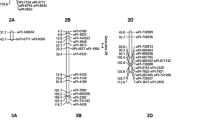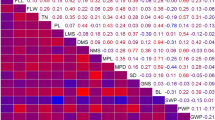Abstract
Cowpea (Vigna unguiculate (L.) Walp.) is a worldwide important multifunctional legume crop for food grain, vegetable, fodder, and cover crop. Nevertheless, only limited research has been conducted on agronomic traits. Here, we report quantitative trait locus (QTL) analysis of the days to flowering (DTF) and plant height (PH) using a dense SNP linkage map recently developed from a recombinant inbred line (RIL) population derived from a cross between Golden Eye Cream and IT98K-476-8. The population was phenotyped for DTF and PH through field and greenhouse trials under two environments. The QTLs controlling these traits were mapped using multiple-environment combined and individual trial phenotypic data. The combined data analysis identified one major QTL (qDTF9.1) for DTF, and one major QTL (qPH9.1) and a minor QTL (qPH4.1) for PH. qDTF9.1 and qPH9.1 were adjacent to each other on Chromosome 9 and each explained 29.3% and 29.5% of the phenotypic variation (PVE), respectively. The individual trial data analysis identified a minor QTL (qDTF2.1) on Chromosome 2 for DTF and two minor QTLs (qPH4.1 and qPH4.2) on Chromosome 4 for PH, while the major QTLs, qDTF9.1 and qPH9.1, were consistently identified in all trials conducted. Epistasis analysis revealed that qDTF9.1 interacted with one locus on Chromosome 4, contributed 50% of the PVE, and qPH9.1 interacted with one locus on each of Chromosomes 4 and 6, contributing 30% and 23% of the PVE, respectively, suggesting that epistasis plays an important role in the trait performance. These results, therefore, provide a deeper understanding of the genetic architecture of plant DTF and PH, and molecular tools necessary for cloning the genes and for enhanced cowpea breeding.



Similar content being viewed by others

References
Andargie M, Pasquet RS, Muluvi GM, Timko MP (2013) Quantitative trait loci analysis of flowering time related traits identified in recombinant inbred lines of cowpea (Vigna unguiculata). Genome 56:289–294. https://doi.org/10.1139/gen-2013-0028
Bressani R (1985) Nutritive value of cowpeas. In: Singh SR, Rachie KO (eds) Cowpea research, production and utilization. John Wiley & Sons Ltd. 355–360
Catchen JM, Amores A, Hohenlohe P, Cresko W, Postlethwait JH (2011) Stacks: Building and Genotyping Loci De NovoFrom Short-Read Sequences. G3 1:171–182. https://doi.org/10.1534/g3.111.000240
Cao Y, Li S, He X, Chang F, Kong J, Gai J (2017) Mapping QTLs for plant height and flowering time in a Chinese summer planting soybean RIL population. Euphytica 213:1–13. https://doi.org/10.1007/s10681-016-1834-8
FAOSTAT (2017) Food and Agriculture Organization of the United Nations. FAOSTAT Statistical Database. [Rome]: FAO. https://www.fao.org/faostat/en/#data. Accessed 12 Dec 2019
Henderson CR (1975) Best linear unbiased estimation and prediction under a selection model. Biometrics 31:423–447. https://doi.org/10.2307/2529430
Kamara AY, Ewansiha SU, Ajeigbe HA, Okechukwu R, Tefera H, Boukar O, Omoigui LO (2011) Improvements in grain and fodder yield of cowpea (Vigna unguiculata) varieties developed in the Sudan savannas of Nigeria over the past four decades. Proceedings of the Fifth World Cowpea Conference 179–188
Koornneef M, Hanhart CJ, van der Veen JH (1991) A genetic and physiological analysis of late flowering mutants in Arabidopsis thaliana. Mol Gen Genet 229:57. https://doi.org/10.1007/BF00264213
Kumawat G, Raje RS, Bhutani S, Pal JK, Mithra AS, Gaikwad K, Sharma TR, Singh NK (2012) Molecular mapping of QTLs for plant type and earliness traits in pigeonpea (Cajanus cajan L. Millsp.). BMC Genet 13:84. https://doi.org/10.1186/1471-2156-13-84
Lonardi S, Muñoz-Amatriaín M, Liang Q, Shu S, Wanamaker SI, Lo S, Tanskanen J, Schulman AH, Zhu T, Luo MC, Alhakami H, Ounit R, Hasan AM, Verdier J, Roberts PA, Santos JRP, Ndeve A, Doležel J, Vrána J, Hokin SA, Farmer AD, Cannon SB, Close TJ (2019) The genome of cowpea (Vigna unguiculata [L.] Walp.). Plant J 98:767–782. https://doi.org/10.1111/tpj.14349
Meena HK, Krishna KR, Singh BB (2015) Character associations between seed yield and its components traits in cowpea [Vigna unguiculata (L.) Walp.]. Indian J Agric Res 49:567–570
Mei DS, Wang HZ, Hu Q, Li YD, Xu YS, Li YC (2009) QTL analysis on plant height and flowering time in Brassica napus. Plant Breed 128:458–465. https://doi.org/10.1111/j.1439-0523.2008.01528.x
Meng L, Li H, Zhang L, Wang J (2015) QTL IciMapping: integrated software for genetic linkage map construction and quantitative trait locus mapping in biparental populations. Crop J 3:268–283. https://doi.org/10.1016/j.cj.2015.01.001
Miller JC, Scheuring DC (2006) “Golden eye cream”: A large-seeded, high-yielding, early-maturing southern pea for the fresh market and home garden. HortScience 41:1709–1710. https://doi.org/10.21273/hortsci.41.7.1709
Ogbuinya PO (1997) Advances in cowpea research. Biotechnol Dev Monit 33:1012. https://www.biotech-monitor.nl/3306.htm. Accessed 12 Dec 2019
Pouteau S, Nicholls D, Tooke F, Coen E, Battey N (1997) The induction and maintenance of flowering in Impatiens. Development 124:3343–3351
Quaye W, Adofo K, Madode YE, Abizari AR (2009) Exploratory and multidisciplinary survey of the cowpea network in Tolon-Kumbungu district of Ghana: a food sovereignty perspective. ISSN 1991–637X. Afr J Agric Res 4:311–320
Saidou AK, Abaidoo RC, Singh BB, Iwuafor ENO, Sanginga N (2007) Variability of cowpea breeding lines to low phosphorus tolerance and response to external application of phosphorus. In: Bationo A, Waswa B, Kihara J, Kimetu J (eds) Advances in integrated soil fertility management in sub-Saharan Africa: Challenges and opportunities. Springer, Dordrecht, pp 413–422
Sanusi MG, Lawan FD (2010) Relationships between some quantitative characters in selected cowpea germplasm [(Vigna unguiculata L. (Walp)]. Notulae Scientia Biologicae 2:125–128. https://doi.org/10.15835/nsb213538
Simpson GG, Dean C (2002) Arabidopsis, the Rosetta stone of flowering time? Science 296:285–289. https://doi.org/10.1126/science.296.5566.285
Singh BB (2014) Cowpea: The food legume of the 21st century. Crop Sci Soc Am, Inc., Madison
Tarawali SA, Singh BB, Gupta SC, Tabo R, Harris F, Nokoe S, Fernández-Rivera S, Bationo A, Manyong VM, Makinde K, Odion EC (2002) Cowpea as a key factor for a new approach to integrated crop–livestock systems research in the dry savannas of West Africa. In: Fatokun CA, Tarawali S, Singh BB, Kormawa PM, Tamo M (Eds.). Proceedings of the world cowpea conference III on challenges and opportunities for enhancing sustainable cowpea production. International Institute of Tropical Agriculture, Ibadan, Nigeria 237–255
Timko MP, Ehlers JD, Roberts PA (2007) Cowpea. In: Kole C (ed) Pulse, sugar and tuber crops, genome mapping and molecular breeding in plants. Springer, Berlin, pp 49–67
Timko MP, Singh BB (2008) Cowpea, a multifunctional legume. In: Moore PH, Ming R (Rds). Genomics of tropical crop plants. Springer Science + Business Media LCC, New York 227–258
Tukey JW (1949) Comparing individual means in the analysis of variance. Biometrics 5:99–114. https://doi.org/10.2307/3001913
Turk KJ, Hall AE, Asbell CW (1980) Drought adaptation of cowpea. I. Influence of drought on seed yield1. Agron J 72:413–420. https://doi.org/10.2134/agronj1980.00021962007200030004x
Ubi BE, Mignouna H, Thottappilly G (2000) Construction of a genetic linkage map and QTL analysis using a recombinant inbred population derived from an intersubspecific cross of cowpea (Vigna unguiculata (L.) Walp.). Breed Sci 50:161–172. https://doi.org/10.1270/jsbbs.50.161
Acknowledgements
This work was supported by the Agriculture and Food Research Initiative competitive grant no. 2014-67013-21590 of the USDA National Institute of Food and Agriculture.
Author information
Authors and Affiliations
Corresponding author
Ethics declarations
Conflict of interest
The authors declare that they have no conflict of interest.
Ethical standard
The experiments comply with the ethical standards in the country in which they were performed.
Additional information
Communicated by Stefan Hohmann.
Publisher's Note
Springer Nature remains neutral with regard to jurisdictional claims in published maps and institutional affiliations.
Electronic supplementary material
Below is the link to the electronic supplementary material.
Rights and permissions
About this article
Cite this article
Angira, B., Zhang, Y., Scheuring, C.F. et al. Quantitative trait loci influencing days to flowering and plant height in cowpea, Vigna unguiculata (L.) Walp. Mol Genet Genomics 295, 1187–1195 (2020). https://doi.org/10.1007/s00438-020-01680-y
Received:
Accepted:
Published:
Issue Date:
DOI: https://doi.org/10.1007/s00438-020-01680-y



